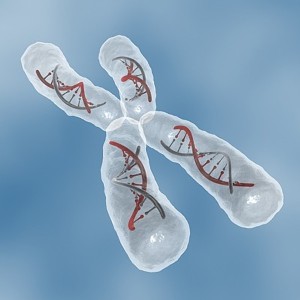 An important androgen receptor gene is located on the X chromosome
An important androgen receptor gene is located on the X chromosomeThere are many theories on the genetics of hair loss. You may have heard the popular myth that hair loss is passed down to men from the mother’s side of the family and to women from their father’s side. These myths travel alongside countless other genetic theories regarding how hair loss may be transmitted from one generation to the next.
While it is clear that hereditary male pattern baldness (androgenetic alopecia), is genetically-based and that common baldness cannot occur without the presence of specific inherited genes, we now know that these genes can be passed to offspring from either parent. What is still unclear is the exact mode of inheritance and the relative importance of each parent.
Many theoretical models have been proposed that focus on one particular dominant gene, but what is becoming apparent is that genetic hair loss is a polygenic trait. Hereditary hair loss is a complex genetic condition, most likely involving the expression of many different genes.
Historically, genetic engineering in hair loss took a single gene approach. This is where a single gene was examined in a specific group of people or families. Then another single gene would be examined in a specific group and so on. The myth that hair loss is passed down from a specific side of the family originated from a paper published in 1916 in which Dr. Dorothy Osborne stated that a specific pattern of baldness was inherited from only one specific parent. This theory has since been proven to be false. It is now known that genetic hair loss is a complex trait that may have contributing factors from both sides of the family. And because gene expression is related to a number of other factors (age, stress, hormone levels, etc.) simply inheriting the genes for baldness does not mean that the trait will manifest in such a way that it alters the person’s appearance.
- More about Hair Loss Genetics
- Answers
- Research
- Glossary
- Consultation
Understanding the genetics of hair loss has practical implications for both the diagnosis and treatment of baldness.
- Early Diagnosis – Identify those at high risk of becoming bald, before it is apparent clinically, so that hair loss can be treated in its earliest stages where medications have the greatest chance of being successful.
- Gene Therapy – Fortunately, the scalp is readily accessible to topical therapies as it allows direct penetration of a drug to a target area. It is theoretically possible to introduce genetic material directly into cells using liposome-DNA mixtures that carry the missing gene(s) to generate new hair.
Please see our further resources on this complex but fascinating topic:




